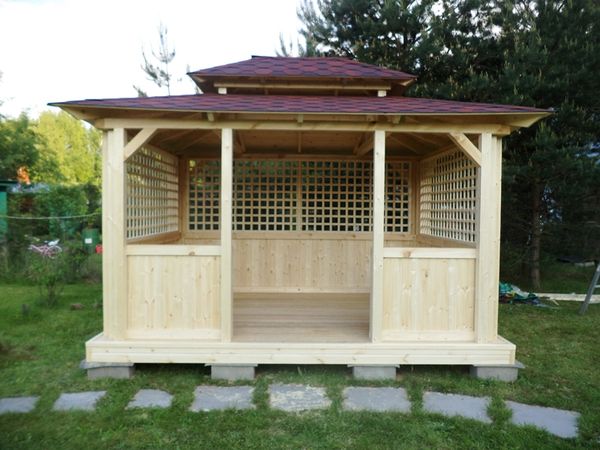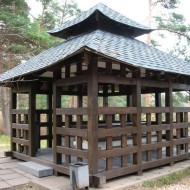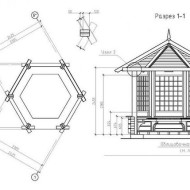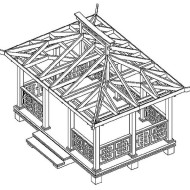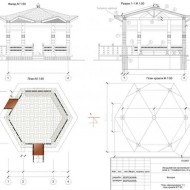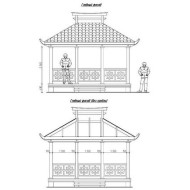Japanese-style gazebo - a piece of Asia in your garden
Content
Design and style features
The shape of the gazebo can be round or square. The main thing that gives the building a Japanese style is a multi-tiered roof (pagoda). According to Eastern philosophy, such a roof instills pacification, giving rise to a sense of harmony with the surrounding world.
Let's list the main design features:
- The roof has a slight concave curve and is much wider than the base.
- In the upper part of the pagoda is pointed, the ribs are curved. This architecture gives the building lightness and airiness.
- The Japanese gazebo is always open, the walls are almost absent. To protect visitors from heat or precipitation, curtains made of linen or other strong material, beige or pastel colors, are used.
- Taking into account the peculiarities of the domestic climate, you can cover the walls with decorative gratings that can withstand gusts of wind. In the future, climbing plantings are allowed along the trellises.
- The gazebo can be positioned on stilts, enhancing the feeling of weightlessness, and can also be provided with a curved bridge.
Although in the East, pagodas are built using reeds, bamboo and rice paper, these materials are not very suitable for our climate, not to mention the difficulty of acquiring them in the right quantities. The reed lends itself easily to dampness; the wind will soon begin to flutter the paper partitions. In domestic realities, it is worth giving preference to more durable natural materials - wood and stone, this is quite in Eastern customs.
The colors of the gazebo are chosen muted, bright colors are incompatible with a state of rest and solitude. No flashlights in flashy colors! This is Japan, not China.
Video "Japanese-style gazebo for a summer residence"
This video will show you how to make a Japanese-style wooden gazebo with your own hands.
Self-construction
The location for the gazebo in the country should be selected secluded, away from noisy streets, in the shade of trees, with beautiful views of the surrounding landscape. It is desirable that there is a stream nearby or at least a decorative fountain - the noise of flowing water helps to relax.
Please note that such a structure, according to Eastern culture, must be oriented to the cardinal points:
- a blank wall should face north or south - this will help keep cool in the summer heat;
- the side walls and the entrance are to the west or east, allowing you to enjoy the views of the sunset and sunrise.
To build a gazebo with your own hands, you will need tools that make it easier and faster to work with wood. It is advisable to have on hand:
- circular and vertical band saws;
- milling and planing machines;
- thickness gauge.
However, if you wish and perseverance, you can build a gazebo in the Japanese style with hand-made carpentry and carpentry tools. You must have the appropriate skills.
Having picked up a suitable drawing, decide in advance on the dimensions, the amount of materials, and calculate the costs. You can build six or even octagonal structures, although for beginners it is easier to start with a square or round shape.
Suitable materials:
- even, processed logs or wide beams as support pillars;
- hardwood timber 10-15 cm thick for walls;
- roof boards;
- suitable roofing material.
Base
First, the site is prepared:
- The site is cleared of debris, stones and tree roots.
- Remove the top sod to a depth of 30 cm to prevent weed growth.
- According to the drawing, markings of the future structure are applied.
- Pegs are placed in the corners, marking the location of the support posts.
You can get by with a lightweight foundation, wood is a light material. A columnar or pile type is suitable. To bookmark:
- Pits are made in the ground, the bottom is covered with a sandy pillow.
- The pillars are installed in such a way that they rise above the ground by 30 cm or more, the gazebo should seem to "float" in the air.
- Pits with support posts are concreted.
The area around can be paved with stone or paving slabs.
Wall frame
When the concrete hardens, a lower strapping of solid timber is organized on the supports. Next, a timber for the walls is vertically mounted on the harness. For convenience, floorboards can already be laid out along the lower strapping - this will make it easier to walk, and the frame will begin to assemble faster.
Having fixed the wall beam strictly vertically and fastened it with lags, mount the upper strapping on top. It will anchor the walls and serve as the basis for the tiered roof.
Roof
Roof tiers are mounted by laying pre-prepared boards. The effect of raising the corners is achieved by filing the boards installed at the edges. By giving them some rounding, it is possible to obtain the required Japanese flavor.
The tiers are firmly fixed to each other. Each subsequent one is made smaller.
Having collected the required number of tiers (usually two are enough), they are sheathed with boards on top. Then the material is painted and then covered with soft tiles. The uppermost tier is covered first, followed by all the lower ones in turn.
The ridge can be made from cut petals.
Upon completion, proceed with the installation of the floor covering, leaving minimal gaps for the outflow of water. If desired, a plinth is laid out in the center for a barbecue oven and erected from bricks, then decorating with stylized tiles. Now it will be possible to organize traditional Japanese tea drinking in the gazebo.
Floorboards are painted in dark red tones, varnished.
Decor
Under the ceiling, lamps in the form of traditional Japanese lanterns will look to the place. Two pieces are enough for lighting. The walls are decorated with tulle curtains, another option is covered with rice paper.
In the depths of the structure, it is advisable to organize a niche in which a suitable oriental decoration is placed:
- strict composition of flowers;
- a scroll with picturesque drawings;
- calligraphic letters.
The original building in oriental style will serve as the main decoration of the site for a long time.
The owners will receive an excellent oasis of peace and serenity.

